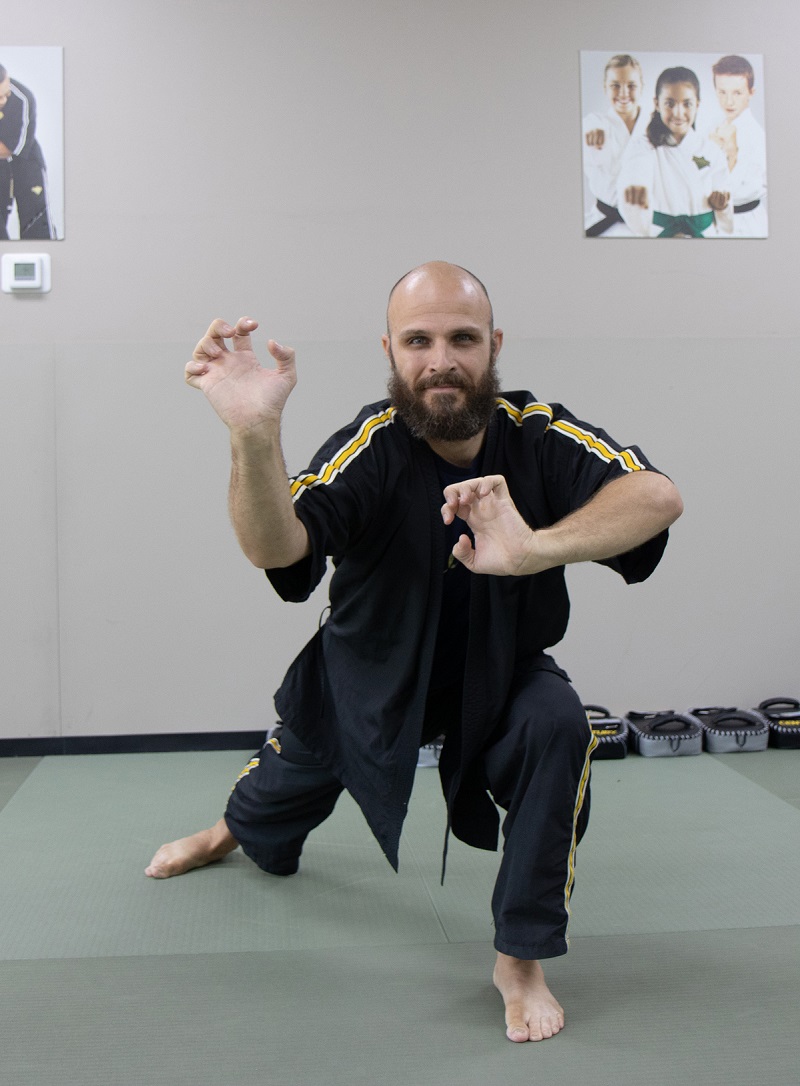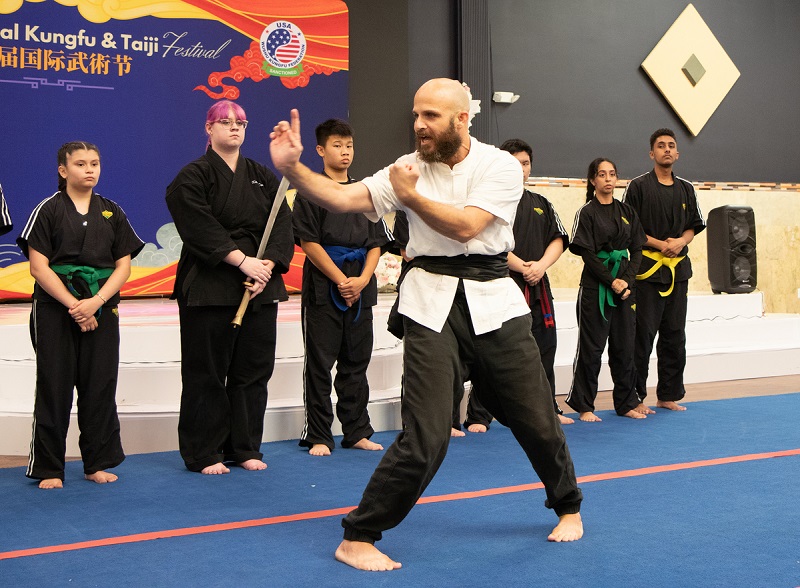
Jacob Brinnad strikes a hung gar martial arts pose at his school in Katy, Texas on Sept 9. May Zhou / China Daily
Growing up in the Bay Area, Jacob Brinnand spent a lot of time in the Asian and Pacific Islander community where martial arts was a big part of the culture.
"I became really interested in martial arts when I was a kid. I loved it," Brinnand said. "I always watched kung fu movies growing up. Drunken Master II with Lau Kar-leung and Jackie Chan was one of my favorites."
He took martial arts classes, but never found the kind of legacy he saw in those kung fu movies. "I couldn't find a good teacher. I couldn't find authenticity."
A lucky star shone upon him when in early 2005 he met Y. C. Wong, a fourth-generation disciple of direct lineage from grandmaster Wong Fei-hung when he was going to college.
Wong Fei-hung, a legendary figure from the Qing Dynasty (1644-1912) to early Republic of China (1912-1949), was famous for his superb martial arts skills in hung gar and drunk boxing as well as his practice of dit da (traumatology and bone setting in traditional Chinese medicine). More than 100 films have been made about his life.
"I was a young man that didn't have a lot of direction in my life. I was living in inner city San Francisco at the time, a colorful neighborhood with different personalities. I was on a self-destructive path," Brinnand said. "Going to Chinatown was a way of finding a remarkable human being. In 2005, I met with great-grandmaster Y.C. Wong and I became obsessed."
At that time, Wong was in his 70s and had dedicated his whole life to kung fu. He's been teaching kung fu in San Francisco since 1960s
"He decided to take me, a young kid, on, and show me the ways of this ancient art. To me, that was a great honor. He didn't hide anything from me. It was like an initiation."
"There were times where I didn't have money, and my old sifu (master) would pay for my meals. He would tell me, don't worry, keep coming to class, keep training. There were many times he showed us incredible amounts of kindness and strength without asking for anything in return."

Jacob Brinnand demonstrates hung gar martial arts at the opening ceremony of the First International Kungfu and Taiji Festival in Houston on Aug 22. May Zhou / China Daily
Brinnand witnessed how Y. C. Wong modeled his life after Wong Fei-hung, and also practiced dit da. "So, not only was he a master of fighting, but also he was a healer."
Being benevolent and strong, Wong is kung fu, said Brinnand. "As a human being, that is a rare thing in this world."
In 2007, Brinnand went to China to take part in the 160th anniversary of Wong Fei-hung's birth as one of his lineage disciples, among whom only a few were Westerners.
"For 12 days we traveled on a bus with masters and living legends together all over Guangdong. I got to sit shoulder to shoulder with people who were born in the early 1900s and they got to see us demonstrate."
During that trip, he watched lion dance, performed for more than 10,000 people beside the gigantic Guan Yin statue on Hainan Island, Wong Fei-hung Memorial Center and other locations, went to the Dragon Boat Festival, and saw performances from a worldwide gathering of masters.
He compared the performances in front of a big crowd plus a council of about 40 hung gar masters to "pressure cooking".
"I trained harder than I ever trained in my whole life and that's how I got a lot better because I was not going up there and make a fool out of myself."
Some of the big-name hung gar masters who played in popular kung fu movies produced by the Shaw Brothers Studios were also there. One day, Brinnand had a close encounter with Gordon Liu, who starred in more than 100 films, most of them the kung fu genre including The 36th Chamber of Shaolin and Quentin Tarantino's Kill Bill series.
"I froze. I was sitting next to Gordon Liu, the living legend. He turned over and he's like, 'you guys' demonstration, that was really good.' The living legend who popularized kung fu turned to us Westerners — there were only four of us — and talked about our kung fu. It was so amazing."
From Wong, Brinnand said he learned that kung fu isn't just about beating somebody down. "It is for health, it is for strength, it is for longevity, it is for healing, it is for helping the community, it is for being a part of the community," Brinnand said. "I've never seen that before."
Brinnand appreciated the fact that Wong brought him, a Westerner, "to experience the old world of China" and to be "taught the tradition without any secrets."
Wong sent him Chinese classic texts from time to time. "I've got them all translated and when you read it, it is profound. It's profound in the sense where it really makes you stop and observe deeply."
He got hooked on the Tao Te Ching and has been listening to it day in and day out, hundreds of times so far. He also studied Lao Tze, and the Vedanta from India.
Those introspections had Brinnand examine his life. In the end, he quit his marketing and advertising business that once employed about 100 people and devoted his life entirely to kung fu. After all, he didn't find fulfilment in money.
"This is what needs to be done. I need to go back to where my sifu began, and this brings goodness and strength," Brinnand said.
The new path took him to Houston, Texas about three years ago to teach and practice kung fu full time. Besides teaching young kids basic skills, he also trains about 50 teenagers and adults, who are serious about learning kung fu, to learn hung gar.
"Now my biggest passion is helping others succeed and watch them blossom," he said.





